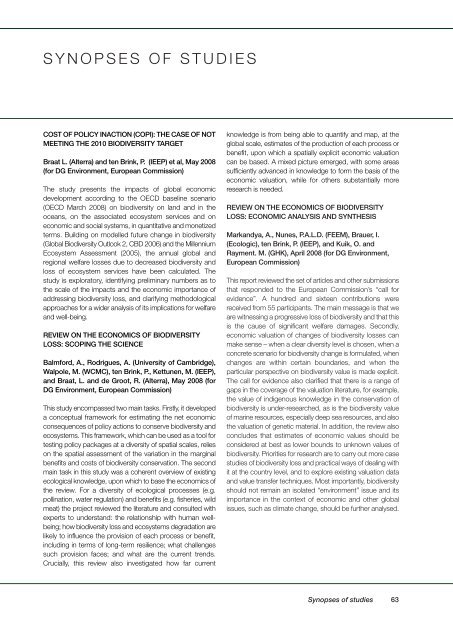Interim Report - TEEB
Interim Report - TEEB
Interim Report - TEEB
You also want an ePaper? Increase the reach of your titles
YUMPU automatically turns print PDFs into web optimized ePapers that Google loves.
S Y N O P S E S O F S T U D I E S<br />
COST OF POLICY INACTION (COPI): THE CASE OF NOT<br />
MEETING THE 2010 BIODIVERSITY TARGET<br />
Braat L. (Alterra) and ten Brink, P. (IEEP) et al, May 2008<br />
(for DG Environment, European Commission)<br />
The study presents the impacts of global economic<br />
development according to the OECD baseline scenario<br />
(OECD March 2008) on biodiversity on land and in the<br />
oceans, on the associated ecosystem services and on<br />
economic and social systems, in quantitative and monetized<br />
terms. Building on modelled future change in biodiversity<br />
(Global Biodiversity Outlook 2, CBD 2006) and the Millennium<br />
Ecosystem Assessment (2005), the annual global and<br />
regional welfare losses due to decreased biodiversity and<br />
loss of ecosystem services have been calculated. The<br />
study is exploratory, identifying preliminary numbers as to<br />
the scale of the impacts and the economic importance of<br />
addressing biodiversity loss, and clarifying methodological<br />
approaches for a wider analysis of its implications for welfare<br />
and well-being.<br />
REVIEW ON THE ECONOMICS OF BIODIVERSITY<br />
LOSS: SCOPING THE SCIENCE<br />
Balmford, A., Rodrigues, A. (University of Cambridge),<br />
Walpole, M. (WCMC), ten Brink, P., Kettunen, M. (IEEP),<br />
and Braat, L. and de Groot, R. (Alterra), May 2008 (for<br />
DG Environment, European Commission)<br />
This study encompassed two main tasks. Firstly, it developed<br />
a conceptual framework for estimating the net economic<br />
consequences of policy actions to conserve biodiversity and<br />
ecosystems. This framework, which can be used as a tool for<br />
testing policy packages at a diversity of spatial scales, relies<br />
on the spatial assessment of the variation in the marginal<br />
benefits and costs of biodiversity conservation. The second<br />
main task in this study was a coherent overview of existing<br />
ecological knowledge, upon which to base the economics of<br />
the review. For a diversity of ecological processes (e.g.<br />
pollination, water regulation) and benefits (e.g. fisheries, wild<br />
meat) the project reviewed the literature and consulted with<br />
experts to understand: the relationship with human wellbeing;<br />
how biodiversity loss and ecosystems degradation are<br />
likely to influence the provision of each process or benefit,<br />
including in terms of long-term resilience; what challenges<br />
such provision faces; and what are the current trends.<br />
Crucially, this review also investigated how far current<br />
knowledge is from being able to quantify and map, at the<br />
global scale, estimates of the production of each process or<br />
benefit, upon which a spatially explicit economic valuation<br />
can be based. A mixed picture emerged, with some areas<br />
sufficiently advanced in knowledge to form the basis of the<br />
economic valuation, while for others substantially more<br />
research is needed.<br />
REVIEW ON THE ECONOMICS OF BIODIVERSITY<br />
LOSS: ECONOMIC ANALYSIS AND SYNTHESIS<br />
Markandya, A., Nunes, P.A.L.D. (FEEM), Brauer, I.<br />
(Ecologic), ten Brink, P. (IEEP), and Kuik, O. and<br />
Rayment. M. (GHK), April 2008 (for DG Environment,<br />
European Commission)<br />
This report reviewed the set of articles and other submissions<br />
that responded to the European Commission’s “call for<br />
evidence”. A hundred and sixteen contributions were<br />
received from 55 participants. The main message is that we<br />
are witnessing a progressive loss of biodiversity and that this<br />
is the cause of significant welfare damages. Secondly,<br />
economic valuation of changes of biodiversity losses can<br />
make sense – when a clear diversity level is chosen, when a<br />
concrete scenario for biodiversity change is formulated, when<br />
changes are within certain boundaries, and when the<br />
particular perspective on biodiversity value is made explicit.<br />
The call for evidence also clarified that there is a range of<br />
gaps in the coverage of the valuation literature, for example,<br />
the value of indigenous knowledge in the conservation of<br />
biodiversity is under-researched, as is the biodiversity value<br />
of marine resources, especially deep sea resources, and also<br />
the valuation of genetic material. In addition, the review also<br />
concludes that estimates of economic values should be<br />
considered at best as lower bounds to unknown values of<br />
biodiversity. Priorities for research are to carry out more case<br />
studies of biodiversity loss and practical ways of dealing with<br />
it at the country level, and to explore existing valuation data<br />
and value transfer techniques. Most importantly, biodiversity<br />
should not remain an isolated “environment” issue and its<br />
importance in the context of economic and other global<br />
issues, such as climate change, should be further analysed.<br />
Synopses of studies<br />
63

















